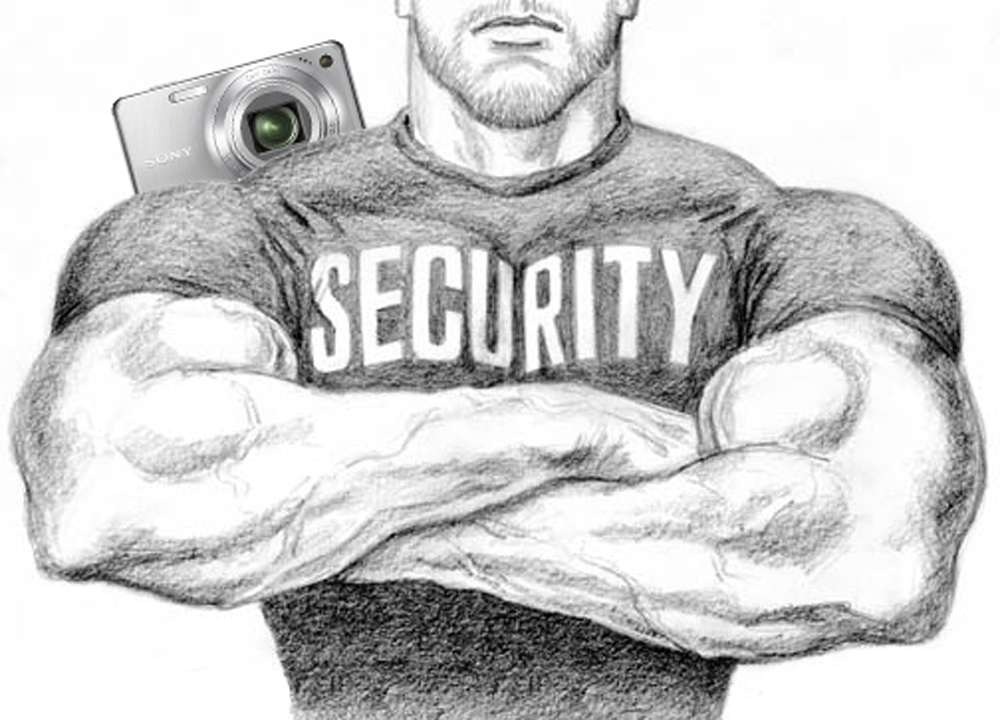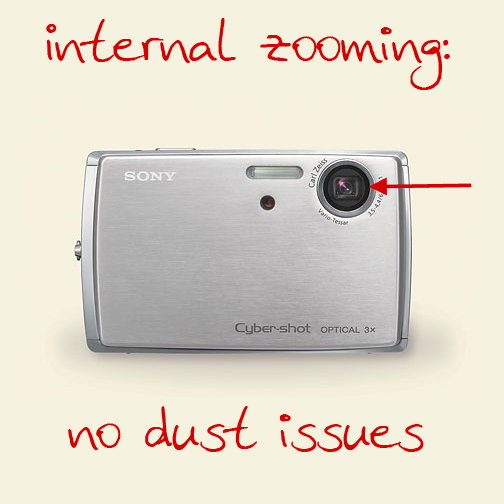Purchasing a new camera can be a big investment (Unless you got one as a present), and it deserves to be treated well. Like any child, or significant other it needs attention and compassion, or it will leave you and start abusing drugs. With the proper care, your camera can last you a lifetime. Literally. This is a guide to protecting your precious equipment against the elements, pets, wear & tear, kids, acts of god and aliens.
1. No Glove, No Love
Just like using condoms, this might be a no-brainer, but I can’t tell you how many cameras I’ve seen over the years that have been neglected and ignored. Whenever your precious camera is not in use, make sure to keep it in its designated camera bag or case. If you (or your family) were too cheap to buy one, a plain old plastic bag will due. Keeping the camera concealed will protect it from dust, and moisture. If your camera bag/case has padding, it will also protect it from bumps and vibrations during travel/transport. This applies to every type of camera. Some people even go to extremes of protecting their camera with body covers, but I see this as a bit excessive. I generally feel that covers or skins on cameras and cell phones generally take away from the ergonomics of the device and add unnecessary bulk. However, if you’re a klutz or you plan on taking pictures from within a mosh pit, I say go for it.
2. Water
 This also goes, without saying, but keep your camera dry! If you’re going to be shooting in a situation where there splashing water, protect your camera for the anticipated degree of water exposure. For example: If it’s just drizzling outside, wrapping a plastic bag around your camera is the quickest and cheapest way to protect it. dSLR owners can wrap a rubber band around the lens for keeping it in place. If however you plan to go scuba diving, and you want to capture pictures of the sharks eating your girlfriend, you might want to invest in an underwater housing. Especially if your camera was worth a paycheck or two.
This also goes, without saying, but keep your camera dry! If you’re going to be shooting in a situation where there splashing water, protect your camera for the anticipated degree of water exposure. For example: If it’s just drizzling outside, wrapping a plastic bag around your camera is the quickest and cheapest way to protect it. dSLR owners can wrap a rubber band around the lens for keeping it in place. If however you plan to go scuba diving, and you want to capture pictures of the sharks eating your girlfriend, you might want to invest in an underwater housing. Especially if your camera was worth a paycheck or two.

When you’re out in the summer heat it’s important to keep your camera as cool as possible. If you’re laying out at the beach or a park, make sure to shield your camera from the sun when its not in use. But be careful. Keeping it in a dark camera bag or plastic bag may actually cook it even quicker. Remember, your camera is just like you. It needs ventilation. How comfortable would you be sitting in a parked car in 100 degree heat with the windows up and no AC? You’d rather be under an umbrella with a cool breeze blowing over you, right? Try covering your camera with a light colored cloth. Dark colors can absorb heat. And make sure it can breathe.
4. Cold

Frigid temperatures are not as troublesome for digital cameras, but as with all electronics in cold weather, there are a couple hazards to be aware of. Condensation is the sneakiest of enemies to avoid. Let’s go back to 8th grade Earth Science for a moment. There is moisture in the air at all times. This humidity percentage can depend on your geographical location, the time of year, the time of day, indoors or outdoors, etc. Humidity is basically water floating around the air in the form of gas. And what happens when a gas cools? It becomes a liquid. If you’re on vacation in Aruba for example, and your camera has been sitting in your dry, 69 degree air conditioned hotel room, your camera is going to be relatively cold. When you bring it outside into the 95 degree humid atmosphere, it’s going to suck up all that water like a sponge. Just like a glass of ice water or a can of soda sweats in the summer heat, your camera is inviting water to come inside and make itself at home. The same thing can occur if you’re shooting in cold winter weather outside, and then bring your camera into a warm and humid atmosphere like a sauna or busy kitchen.
To avoid this deadly scenario, you’ll need to make your camera the same temperature as the outdoors/indoors when transitioning. Keep it concealed from the air by keeping it in its camera bag or a plastic bag (or two). Wait at least a half hour before taking it out for use. If you do happen to make this error in judgement, take out the battery and let it dry out overnight somewhere warm and dry.
5. Dust, Debris & Dirty Fingers
For all intents and purposes, your camera’s lens is its eyeball to the world. It needs it’s eye to to see clearly. Protecting it is essential to your camera’s well being and happiness.
a. Dust & Debris:
Most point and shoot cameras come with a lens cover that electronically opens and closes when you turn the camera on or off. The same mechanism makes the lens pop in and out of your camera and is also used for zooming. Owners of these cameras don’t have to worry about long term glass protection, but all those moving parts wont function properly if your camera is constantly exposed to large quantities of dust for extended periods. An example: My father works in construction as a Project Manager. Part of his job is to constantly document photos of work progress during the course of a project. He had used several Sony point-and-shoot cameras over the years that all failed after about 18 months of use. The lens would no longer extend/retract due to the amount of dust that had accumulated in the crevasses of all the moving parts. He also never covered his cameras back then. If you’re planning on regularly shooting photos in environments like this, I strongly recommend you use a point and shoot with internal zooming and a fixed lens. The cost is a tiny bit more expensive. You’l be paying a small premium for a more compact package and the research and development that went into producing smaller lenses with similar performance and optical quality. But you’ll be more at ease knowing that dust will have an infinitely harder time trying to penetrate your camera.
dSLR owners need to take similar precautions for dust and debris. The glass element on your lens is much larger than ordinary point and shoot cameras, and therefore more susceptible to damage. There are no automatic lens caps for dSLRs. They must be manually taken off and put back on every time the camera is used. The problem with this is that most people either get lazy and leave it off all the time, or lose the cap altogether. The solution is a $2 lens cap keeper. When you’re shooting, the cap simply hangs off your lens so you never lose it.
Also recommended for dSLR owners is a neutral density filter. This is just a fancy name for lens protector. It’s just a simple extra piece of glass that screws on to your lens. If it ever gets damaged, just toss it and get another. it will be much cheaper than replacing a $2,000.00 lens. There is a minuscule amount of light loss associated with having a ND filter on, but the camera compensates for it automatically, and you’d much rather have your glass protected at all times. ND filters have threads on both sides so that you can also add other filters on top if you need to, and they work with your existing lens cap. I always purchase one with a new lens and put it on immediately after unboxing in a clean, dust-free environment.
b. Dirty Fingers:
While you were eating a Philly Cheese Steak in Philadelphia, you noticed Sylvester Stallone walking by and scrambled to get your camera. In your haste, you got grease all over the lens and camera body. You emailed Sly the pictures, and he was thankful because the blurry lens made him look younger. But you still have grease on your lens. How do you get it off? DO NOT rub it with the ugly wool sweater you got for Christmas. This is not smart. These lenses are delicate precision instruments that took long hours to assemble by hand, and you’re just gonna smear it with a Brillo pad?? Get yourself a decent lens cleaning kit for as little as ten bucks. A typical kit includes a brush for removing dust, a lens cloth and some kind of lens cleaner solution. Do Not Use Windex! If you don’t want to splurge, get a microfiber cleaning cloth at any eyeglass store for a couple bucks. Breathe on your lens before rubbing gently.
6. Kids, Pets, Aliens and Acts of God

Finally, there are some camera hazards we really can’t always predict. They key here is to use your brain and good judgement. It you have a bunch of rugrats scurrying around the house violently, you may want to keep your precious in a drawer or cabinet that they can’t get into. Same goes for pets. Dogs will chew on anything they can wrap their jaws around and cat pee has one of the most deadly smells on earth. Keep your camera vaulted around the house. If Aliens do visit your home, its a good idea to have your camera handy for emailing photos to the National Enquirer the next morning. If the world ends in 2012, chances are you’ve got bigger concerns, but having access to warranty documents never hurts.









the sand is stuck to the rubber grips on my sigma lens… one by one i remove them… ONE GRAIN OF SAND AT A TIME!